Handling WooCommerce import/export product reviews can be challenging, especially since the platform doesn’t offer this feature by default. Without the right tools, it becomes difficult to migrate, back up, or organize customer feedback across different stores efficiently.
In this guide, we’ll help you tackle that challenge by covering:
- Detailed guide on how to import WooCommerce product reviews;
- Step-by-step walkthrough to export product reviews safely;
- The best plugins to automate and optimize both tasks.
Let’s dive in and see how it’s done!
What You Need to Know About WooCommerce Product Reviews
WooCommerce comes with built-in features that let customers leave ratings and feedback directly on product pages. You can display star ratings, enable verified owner labels, and manage reviews from the WordPress dashboard just like regular comments.
Having product reviews on your store brings several key benefits:
- Builds trust and credibility: Real feedback from buyers reassures new customers that your products are reliable.
- Boosts conversion rates: Shoppers are more likely to purchase when they see positive reviews and authentic customer experiences.
- Provides customer insights: Reviews help you understand what buyers value most and identify areas for improvement.
- Improves SEO performance: Review content adds fresh, keyword-rich text to your product pages, helping them rank higher on search engines.
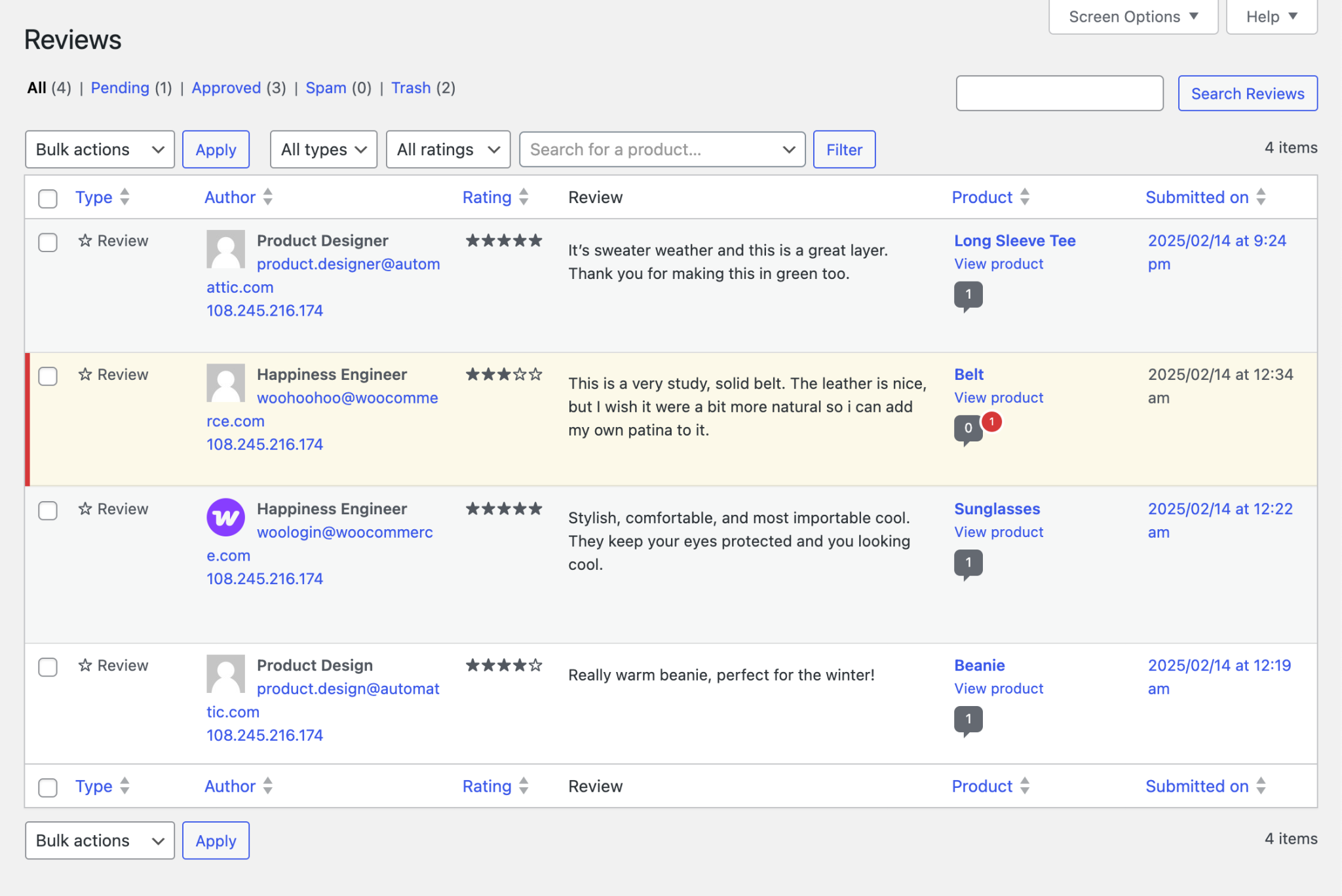
However, WooCommerce doesn’t include any native tools for importing and exporting product reviews. That means if you ever need to move reviews between stores, back them up, or bulk-import them from another source, you’ll need to use a dedicated plugin.
After testing several options, we found the Import Export Suite for WooCommerce by WebToffee to be the most reliable and flexible solution. It handles product reviews import export for WooCommerce seamlessly, supports custom fields, and allows scheduling for recurring tasks. Its interface is intuitive enough for beginners yet powerful enough for complex data setups – which is why we chose it for this step-by-step guide.
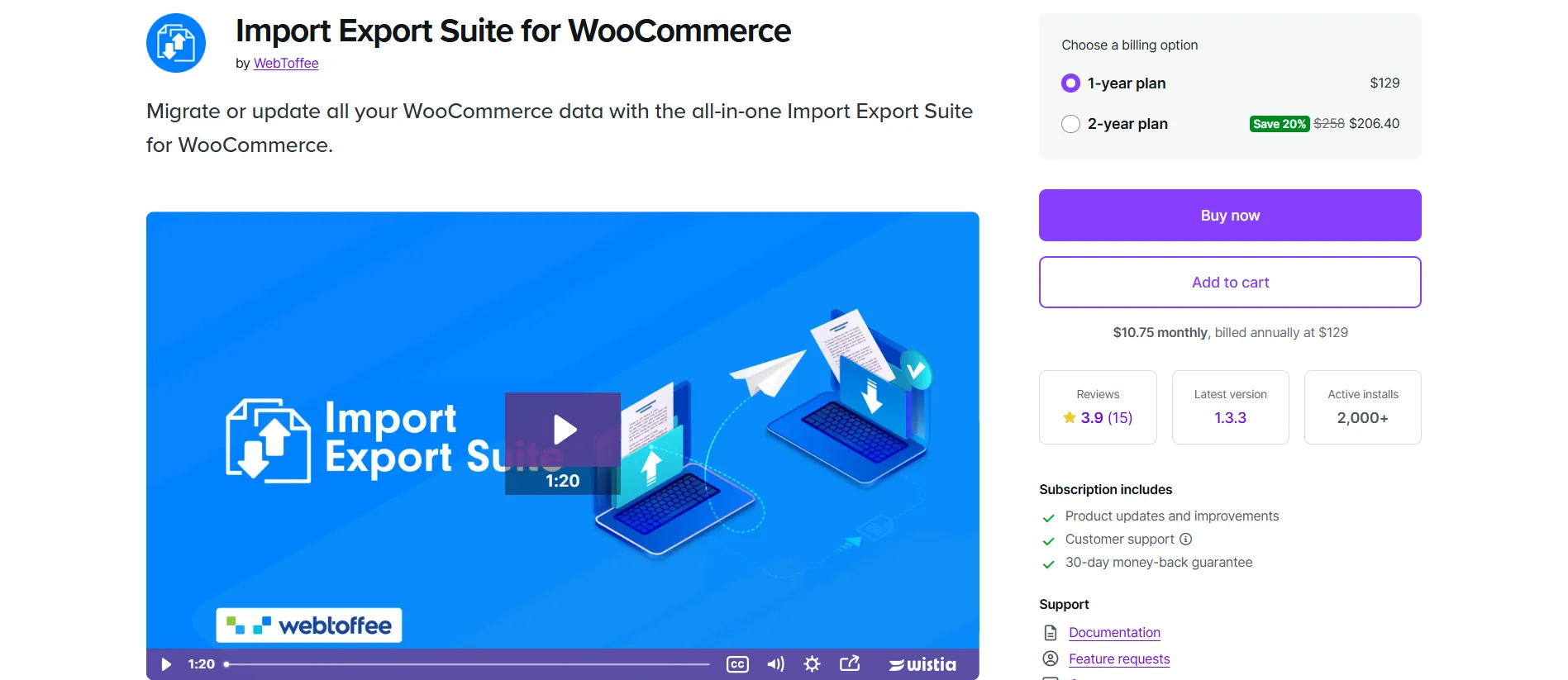
Of course, this isn’t your only option. Depending on your goals – for example, importing reviews from AliExpress, managing CSV files, or syncing data between platforms – you can explore other plugins as well. We’ll cover a few alternatives in this section.
How to Import Product Reviews on WooCommerce?
First, let’s start with importing product reviews into WooCommerce. This process is especially useful in situations like store migration, data restoration after a redesign, or bulk uploading customer feedback from external sources.
As mentioned earlier, we’ll use the Import Export Suite for WooCommerce by WebToffee for this tutorial. It’s a straightforward tool that simplifies the entire process and ensures your review data is imported accurately.
We’ll walk you through the following steps:
- Step 1: Format your CSV file
- Step 2: Choose the post type
- Step 3: Pick the import method
- Step 4: Match and map the import fields
- Step 5: Configure advanced settings
Step 1: Format your CSV file
The first step of the WooCommerce import product reviews process is to prepare your CSV file. This file tells the plugin how to read and assign each piece of information to the correct review field in WooCommerce. Formatting your CSV file correctly is important to ensure the plugin recognizes and places each review in the right field.
For example, the Comment ID column in your CSV should correspond to the comment_ID field in WooCommerce, while the Author Name should match the comment_author field.
Below is a reference template showing how the standard WooCommerce review fields should be structured in your file:
Column heading | Description | Accepted value |
comment_ID | Unique identifier assigned to each review. | Numeric |
product_SKU | Product’s Stock Keeping Unit code. | Alphanumeric, e.g., AD35 |
comment_post_ID | Unique ID of the product the review belongs to. | Numeric |
comment_author | Name of the person who wrote the review. | Text, e.g., John |
comment_author_email | Email address of the reviewer. | Text, e.g., [email protected] |
comment_author_url | Reviewer’s website address, if provided. | URL, e.g., https://www.example.com/ |
comment_author_IP | IP address from which the review was submitted. | Numeric, e.g., 201.73.89.201 |
comment_date | Date and time when the review was submitted. | MM/DD/YYYY H:i:s, e.g., 9/6/2016 6:29:00 |
comment_date_gmt | Submission date and time recorded in GMT. | MM/DD/YYYY H:i, e.g., 9/6/2016 6:29 |
comment_content | Text content of the review. | Text, e.g., Nice product. |
comment_approved | Shows whether the review has been approved. Use 1 for approved, 0 for not approved. | 0, 1, yes, no, YES, NO |
comment_parent | ID of the parent review (leave blank for standalone reviews). | Numeric |
user_id | ID of the reviewer if they have a registered account (otherwise 0). | Numeric |
rating | Product rating provided by the customer. | Numeric, range 1–5 |
verified | Indicates if the reviewer purchased the product. Use 1 for verified, 0 for not verified. | Numeric |
title | Review title or headline. | Text |
product_title | Name of the product being reviewed. | Text |
comment_alter_id | Used during import to handle ID conflicts or link replies to their parent review. | Numeric |
Your file should look like the image below once it’s formatted correctly. When it matches this structure, you’re all set to move on to the next step.
Step 2: Choose the post type
To begin importing your product reviews, open your WordPress dashboard and go to WooCommerce > Import Export Suite. Then, switch to the Import tab.
In this step, you’ll need to select the Post Type as Product Review. This tells the plugin exactly what kind of data you’re importing so it can map your CSV fields to the correct review attributes.

Step 3: Pick the import method
Next, you’ll need to choose how you want to import your product reviews WooCommerce. The plugin provides three methods, depending on how detailed or repetitive your import process needs to be. Let’s go through what each method does.
Method 1: Quick import
This option is ideal for simple or repeated imports. It brings in the standard fields for your selected post type and works best if your input file was originally exported using the same plugin.
You can upload the file directly from your local computer, a URL, or an FTP location.
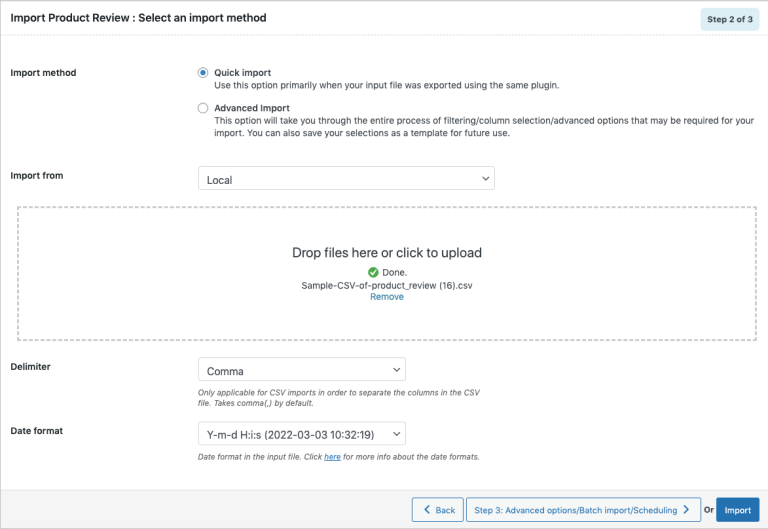
Once your file is selected, click Import to start the process. If you’d like to customize your import further, you can move on to the next step for advanced options.
Method 2: Pre-saved template
If you often import data with the same file structure or settings, then we recommend using the Pre-saved Template method. It lets you reuse filters, field mappings, and configurations saved from a previous Advanced Import, ensuring a faster and more consistent process for recurring imports.
All you have to do is select your saved template from the Import Template dropdown and click Import to begin.
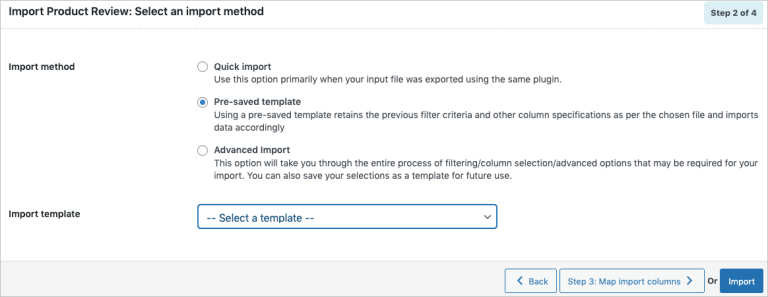
Note: Templates will appear in the dropdown only if you’ve saved them during a previous import. When using the Advanced Import method later, you’ll have the option to save your settings as a template for next time.
Method 3: Advanced import
Users who require complete control over their data will benefit from this approach. It allows filtering data, adjusting column selections, and fine-tuning additional settings before running the import.
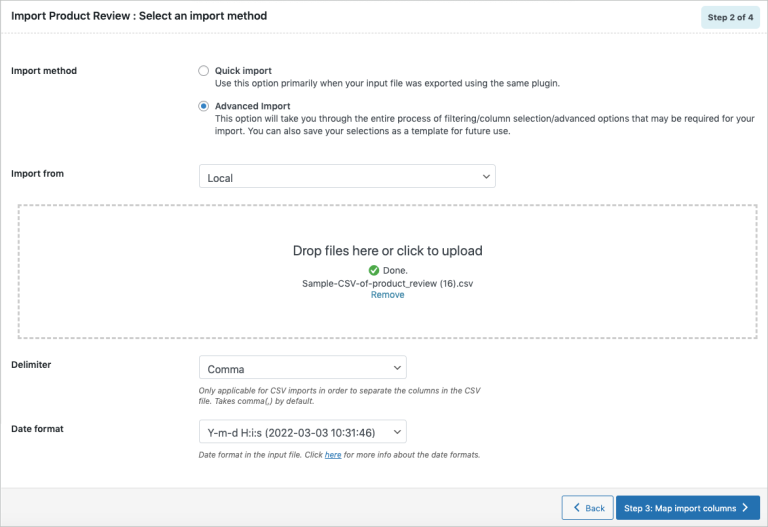
A saved configuration from this method can also serve as a reusable template for future imports, which is particularly helpful when importing product reviews on a regular basis or handling multiple file formats.
Step 4: Match and map the import fields
This step defines how the data from your CSV file connects to the corresponding product review fields in WooCommerce. The plugin organizes the mapping interface into three main sections as follow:
- Default fields: These are the standard WooCommerce review fields that correspond to the column headers in your CSV file. The field names can be adjusted if needed, and when a pre-saved template is applied, the previously saved configurations appear automatically.
- Meta (custom fields): This section handles any additional or custom data not included in WooCommerce’s default review fields. It helps ensure that all extra review information is imported accurately.
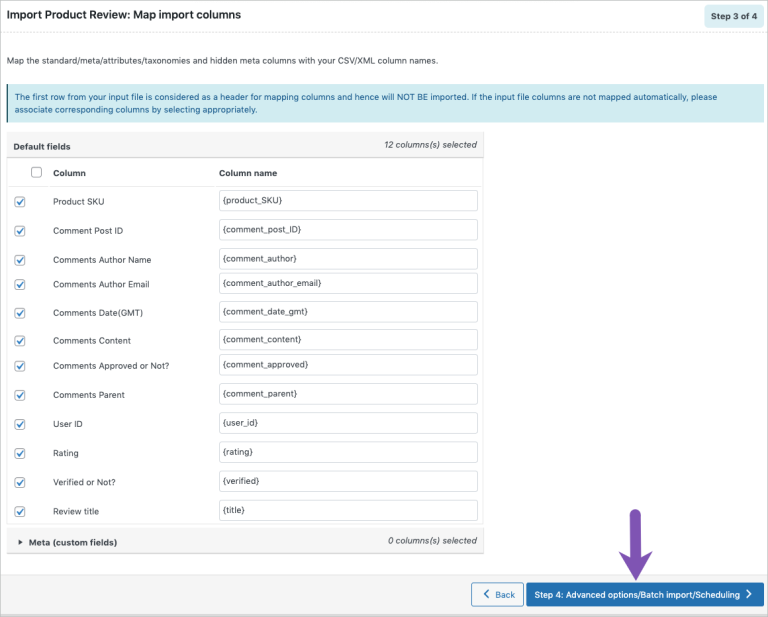
- Evaluate field: This feature allows additional customization during import. It enables the plugin to append or calculate values dynamically while processing your file. Essentially, this field picks a column from the input file, applies an expression, and produces a computed output.
- Expression: Mathematical and logical operators such as +, *, /, -, (), &, @, or text strings can be used to manipulate data values.
- Input: The column selected from the dropdown that will be modified.
- Output: A sample result generated based on the first record in your input file.

Note: If a selected column contains empty cells, the evaluation may trigger syntax errors during import.
Once all columns are mapped correctly, proceed to the last step in the plugin interface to continue.
Step 5: Configure advanced settings
At this stage, the advanced configuration window appears. This section allows adjustments to how product review data is updated, associated, and scheduled during import.
The key settings include:
- Update only: This option determines how existing data is handled. Selecting Yes updates only the matching or existing records in your store. Selecting No processes the entire input file, updating existing entries or inserting new ones as needed.
- If the review already exists: When duplicate reviews are detected, two actions are possible: either Skip the record or Update the existing entry.
- Associate product reviews by SKU: This setting links imported reviews to the correct products based on their product ID or SKU.
Note: Within the Advanced Options section, it is possible to set the number of records the server processes per iteration within the allowed timeout interval. In cases where an import fails due to a timeout, lowering this number can help complete the process successfully.
A template can also be saved at this point for future use, which is helpful when performing regular imports with the same configuration.
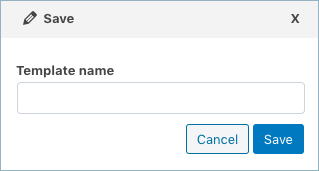
Once all options are reviewed, the process can continue in one of two ways: import or schedule.
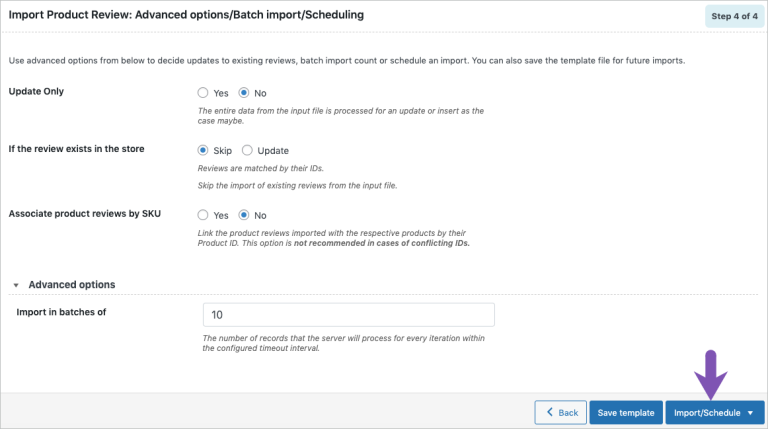
Option 1: Scheduling the import
The Schedule button opens the cron scheduling window, where automated imports can be configured.
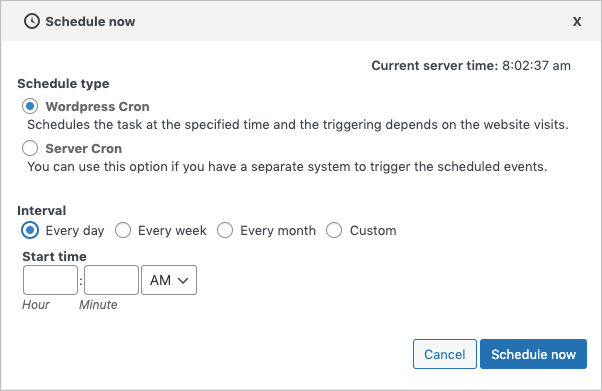
Two types of cron scheduling are supported:
- WordPress cron: This option runs scheduled events based on site activity. Each time someone visits the website, WordPress checks if the scheduled time has passed and triggers the event when appropriate. This approach works best for smaller stores with regular traffic.
- Server cron: This method triggers the import at precise intervals through your hosting server. It generates a unique URL that you can add to your system’s cron job list to automatically trigger the import. This approach is recommended for large stores or sites requiring consistent, time-based automation.
The desired schedule time can be configured, after which selecting Schedule Now activates the automated import.
Option 2: Importing directly
For immediate imports, selecting the Import option starts the process right away. Once the import is finished, a pop-up notification appears, displaying a summary that includes the number of successful imports and any failed entries.
How to Export WooCommerce Product Reviews?
When your store data grows, keeping a copy of customer feedback becomes just as important as collecting it. Exporting WooCommerce product reviews helps you maintain backups, share data across sites, or evaluate customer insights more easily.
To do this efficiently, we’ll continue using the Import Export Suite for WooCommerce by WebToffee, which allows you to export reviews in a clean, structured format.
We’ll walk you through the following steps:
- Step 1: Decide the post type
- Step 2: Select your export method
- Step 3: Filter data
- Step 4: Map and reorder export columns
- Step 5: Adjust advanced settings
Step 1: Decide the post type
The export process begins in the same location as the import function. From your WordPress dashboard, go to WooCommerce > Import Export Suite and open the Export tab.
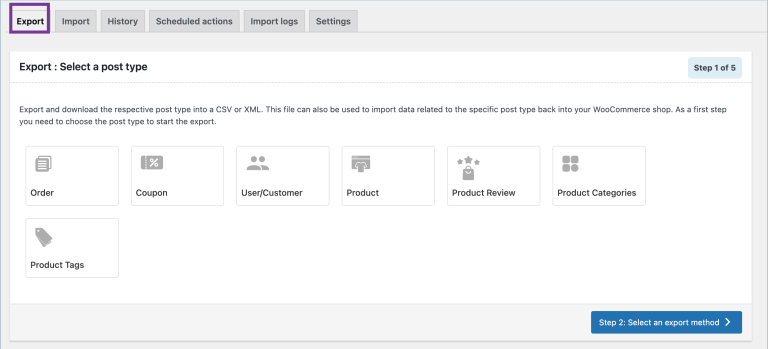
At this stage, the Post Type needs to be set to Product Review. This selection tells the plugin that only product review data should be exported, ensuring that the output file contains the correct information for your store’s reviews.
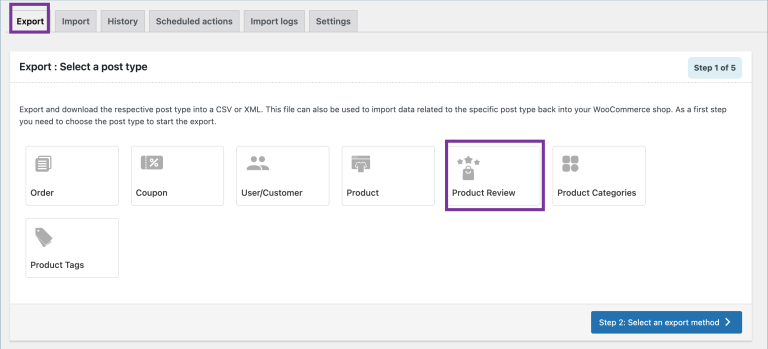
Step 2: Select your export method
Just like with the import process, there are 3 export product reviews WooCommerce methods for you to choose from. Each method serves a slightly different purpose, as explained below:
Method 1: Quick export
The most convenient way to create an export file is by using the Quick Export mode. It automatically gathers the essential WooCommerce review fields and prepares them for download. You can also include extra data by enabling the Meta (custom fields) option.

Method 2: Pre-saved template
A saved template from a previous export makes recurring tasks much easier. The system recalls your earlier configurations (filters, field mappings, and column selections, etc.) so you can export reviews using the same structure without reconfiguring the setup each time.
The desired template can be chosen from the Export Template dropdown menu before generating the file.
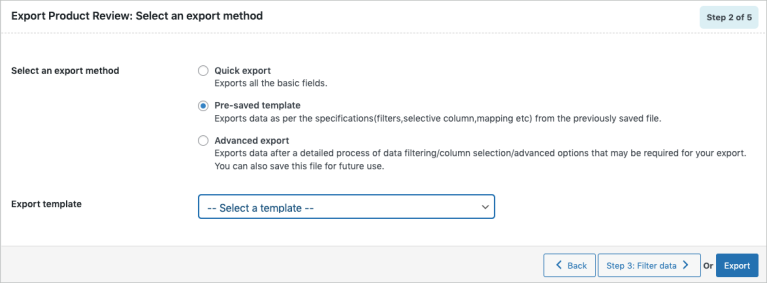
Note: Templates are displayed in the dropdown list only if they have been saved in prior export sessions. During the Advanced Export process, an option to save the configuration as a template becomes available in Step 5. Once saved, the same setup can be reused in future exports.
Method 3: Advanced export
The most detailed setup option is available through Advanced Export. It gives users precise control over what gets exported by allowing filters, column selections, and fine-tuned settings to be applied before generating the final file. This approach is ideal for complex or customized export requirements.

A file generated through this method can also be saved as a template, making future exports easier to repeat with identical configurations.
After reviewing all selections, the process can continue to Step 3 to begin filtering data.
Step 3: Filter your data
The plugin allows you to narrow down which product reviews are exported by setting specific filters. Each filter helps you control what data appears in the final file.
- Total number of reviews to export: The total count of reviews to include in the export. For example, entering 500 with a skip count of 10 exports reviews from positions 11 to 510.
- Skip first n reviews: The number of reviews to exclude from the beginning of the list. For instance, entering 10 skips the first ten reviews.
- Date From: The date from which reviews should be exported. Only reviews received on or after this date will be included.
- Date To: The date up to which reviews should be exported. Only reviews received on or before this date will be included.
- Products: The specific product name for which reviews will be exported.
- Stars: The star rating of reviews to export. This can be used to analyze reviews of a certain rating level.
- Customer/Guest Review: The reviewer type to export — registered customers, guest users, or both.
- Review with replies: Determines whether replies associated with reviews are included in the export file.
- Status: The post status of reviews to export, such as approved or pending.
- Sort Columns: The columns to sort the exported data by, following the sequence specified.
- Sort By: The order in which the exported data should be sorted, set to ascending by default.
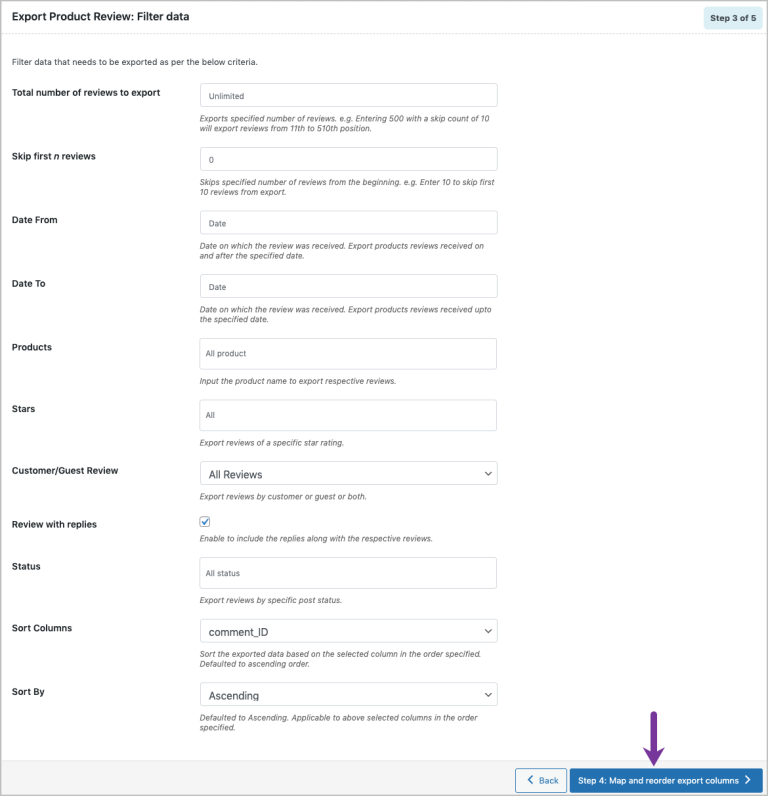
With the filters in place, the setup is ready to proceed to the next step, where the export columns can be adjusted.
Step 4: Map or reorder the export fields
This step allows adjustments to how review data appears in the exported file. Each column shown here represents a field that can be customized before the export is generated.
The column names can be edited when needed, and previously saved preferences will automatically appear if a pre-saved template is selected. Columns can also be rearranged by dragging them into the preferred order, helping ensure the final CSV file matches your desired layout.
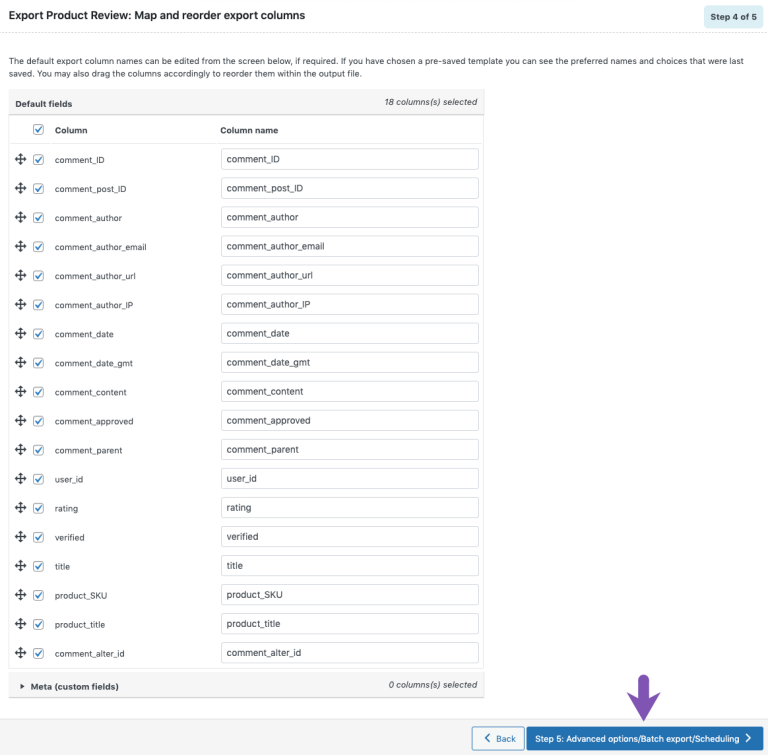
Review data is organized under two main field groups:
- Default fields: Standard WooCommerce product review attributes that are included in every export.
- Meta (custom fields): Additional or custom data that you may have added to reviews beyond the default WooCommerce fields.
After confirming and arranging the columns, the configuration is ready to continue to the next step for advanced settings.
Step 5: Adjust advanced settings
The final step involves reviewing the advanced configuration options before completing the export. This section defines how the exported file will be created and where it will be stored.
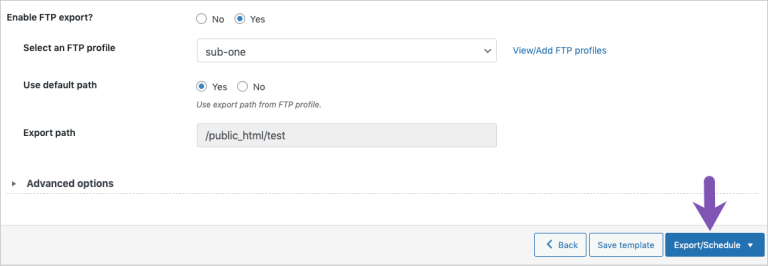
The available settings include:
- Export file name: The name assigned to the export file. If this field is left empty, the system automatically generates a default filename.
- Export file format: The format in which the file will be generated. Both CSV and XML options are supported.
- Delimiter: The character used to separate data columns within the file. A comma (,) is applied by default.
- Enable FTP export: Determines whether the export should be sent directly to an FTP location. Selecting Yes allows an FTP profile and export path to be specified.
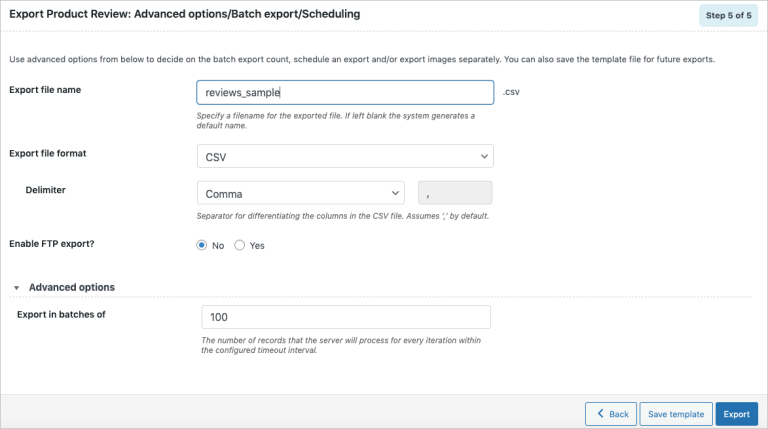
Note: Within the Advanced Options section, it is possible to define how many records the server processes per iteration during the set timeout interval. When a timeout error occurs, lowering this number can help complete the export successfully.
The configuration can also be saved as a template for future exports, ensuring the same settings are available for reuse.

After confirming all details, the process can either generate the export immediately using the Export option or schedule it for a later time.
These steps complete the process of WooCommerce export product reviews. Once configured, the export file can serve as a backup or be used to transfer reviews between stores with ease.
4 Best Plugins for WooCommerce Import Export Product Reviews
As mentioned earlier, importing and exporting WooCommerce product reviews requires the help of a plugin.
From our experience testing different tools, we’ve picked out the 4 best plugins that make the WooCommerce import export product reviews process smoother and more accurate. While these are our top recommendations, there are also other options available depending on your store’s specific goals or workflow.
The table below highlights their pricing, key features, and which types of users each plugin best fits.
Plugin | Plugin | Key features | Recommended for |
Free demo available, automated tool from $59 | • Supports migration of WooCommerce product reviews with full details, including Created Date, Status, Rating, User Name, User Email, and Comment • Transfers products, customers, orders, and other data between platforms with no data loss • Provides a fully automated, hands-off migration process • Allows cross-platform review imports (Shopify, Magento, BigCommerce, and more) • Backed by 24/7 expert support and a dedicated migration team | Store owners migrating away from/to WooCommerce | |
Starts at $99/year | • Imports and exports WooCommerce product reviews, along with products, customers, and orders • Supports CSV/XML file formats with drag-and-drop field mapping • Enables custom import rules and scheduling for recurring tasks • Integrates with Advanced Custom Fields (ACF) and custom post types | Advanced users needing flexible, detailed data control | |
$129/year | • Handles import/export for reviews, products, orders, coupons, and customers • Offers batch processing, scheduling, and field mapping templates • Includes an evaluate field option for adding or modifying data dynamically | WooCommerce users who want an all-in-one, easy solution | |
Free + Premium from $199/year | • Supports WooCommerce review imports and exports with advanced mapping • Works with any WordPress post type: pages, posts, custom post types, and taxonomies • Provides bulk edit and update features • Includes scheduling and media handling for large datasets | Developers managing multiple content types | |
$229 for a regular license | • Imports and exports WooCommerce reviews, products, orders, and categories • Allows custom filtering and sorting before export • Provides cron-based scheduling for automated tasks • Offers a lightweight, straightforward interface for fast setup | Beginners needing a fast, budget-friendly tool |
Each of these plugins offers a reliable way to manage WooCommerce product review data, depending on your store’s needs and technical level. We’ve already covered the best options above, so you can explore and find the one that fits your workflow and goals best.
For merchants planning a complete store migration, LitExtension goes far beyond product reviews. Our service helps transfer your entire store data – including products, customers, orders, and more – with full accuracy and expert support. It’s a hands-off solution designed for busy store owners who want a smooth, secure, and complete move to WooCommerce without dealing with technical steps.
WooCommerce Migration Made Easy With LitExtension!
LitExtension offers great migration solutions that help you transfer your data from the current eCommerce platform to a new one accurately, painlessly with utmost security.

Import & Export WooCommerce Product Reviews: FAQs
How do I add reviews to WooCommerce products?
WooCommerce has a built-in review system that can be enabled in your store settings. Go to WooCommerce > Settings > Products > General, and check Enable product reviews. Customers can then leave ratings and feedback directly on each product page. You can manage, approve, or delete reviews under the Comments section of your WordPress dashboard.
What is the best review plugin for WooCommerce?
For general review management and bulk import/export, Import Export Suite for WooCommerce by WebToffee is a reliable choice. If you want to display advanced review layouts and collect reviews with photos, Customer Reviews for WooCommerce or Judge.me Product Reviews are excellent alternatives.
How do I import product reviews into WooCommerce?
To import reviews, you’ll need a plugin since WooCommerce doesn’t offer this feature by default. The Import Export Suite for WooCommerce plugin allows you to upload a CSV or XML file that contains all your reviews. Each column can then be mapped to the correct WooCommerce field before importing them in bulk.
How to import product reviews from AliExpress to WooCommerce?
Importing reviews from AliExpress requires a specialized tool. Plugins such as AliExpress Review Importer for WooCommerce or AliDropship Woo Plugin can fetch real AliExpress reviews and import them directly into your product pages. These tools usually let you filter by star rating, translate reviews, and include reviewer photos to help boost trust and social proof.
Conclusion
That’s it! You’ve now learned how to import and export WooCommerce product reviews with ease using the right tools. We hope this guide gives you the confidence to manage your store’s review data efficiently and keep everything organized for future growth.
For more information, we still have other WooCommerce tutorials and a community group to help you. Check them out now!

